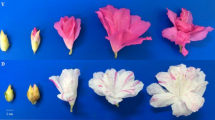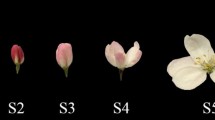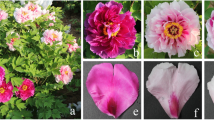Abstract
The flowers of pagoda tree (Sophora japonica L.) are white, which limited its ornamental value and caused few researches on its flower color and anthocyanin accumulation. A pink flower mutant (PM) was discovered, which provided an opportunity to investigate anthocyanin biosynthesis in pagoda tree flowers. In this study, the anthocyanin and flavone/flavonol contents in petals of PM and wild type (WT; white flower) were measured. The content of total anthocyanins was significantly higher in the PM than in the WT at four floral stages (S1–S4). There were no significant differences of total flavonol content between these two varieties at each floral stage, indicating that the flavone/flavonol content did not influence flower color, while anthocyanin was a key factor to determine pink flower coloration. Then, transcriptome analysis was performed by using the petals of PM and WT at S1–S4. Differentially expressed genes encoding chalcone synthase, flavanone 3-hydroxylase, flavonol synthase, flavanone 3′-hydroxylase, dihydroflavonol-4-reductase, anthocyanidin synthase, and UDP-glucose: flavonoid-3-O-glucosyltransferase were identified. Importantly, we found that SjDFR2 might be the key gene in anthocyanin accumulation in petals. Transcription factors, SjPAP1, SjMYB111, SjMYB1b, SjMYBL2, SjTT8, and WD40 protein SjTTG1, might play critical roles in regulation of anthocyanin accumulation in petals. Moreover, regulatory factors involved in the phytohormone signal pathway (SjIAA19, SjIAA27, SjAXR3, SjARF20, and SjERS1), and light signal pathway (SjHY5), were also screened out. These results will provide some new insights into the control of flower color in pagoda tree, as well as some candidate genes to breed novel flower colors using molecular methods.









Similar content being viewed by others
Data Availability
The raw sequence data reported in this paper have been deposited in the Genome Sequence Archive in the BIG Data center, Beijing Institute of Genomics (BIG), Chinese Academy of Sciences, under accession number CRA002363.
References
Alexa A, Rahnenführer J (2006) Enrichment analysis for Gene Ontology. R Package Version
Anders S, Huber W (2010) Differential expression analysis for sequence count data. Genome Biol 11(10):R106
Das P-K, Shin D-H, Choi S-B, Park Y-I (2012) Sugar-hormone cross-talk in anthocyanin biosynthesis. Mol Cells 34:501–507
Ferrero M, Pagliarani C, Novák O, Ferrandino A, Cardinale F, Visentin I, Schubert A (2018) Exogenous strigolactone interacts with abscisic acid-mediated accumulation of anthocyanins in grapevine berries. J Exp Bot 69:2391–2401
Gao L-X, Yang H-X, Liu H-F, Yang J, Hu Y-H (2016) Extensive transcriptome changes underlying the flower color intensity variation in Paeonia ostii. Front Plant Sci 6:1205–1221
Gonzalez A, Zhao M-Z, Leavitt JM, Lloyd AM (2008) Regulation of the anthocyanin biosynthetic pathway by the TTG1/bHLH/Myb transcriptional complex in Arabidopsis seedlings. Plant J 53:814–827
Grabherr MG, Haas BJ, Yassour M, Levin JZ, Thompson DA, Amit I, Adiconis X, Fan L, Raychowdhury R, Zeng Q, Chen Z, Mauceli E, Hacohen N, Gnirke A, Rhind N, di Palma F, Birren BW, Nusbaum C, Lindblad-Toh K, Friedman N, Regev A (2011) Full-length transcriptome assembly from RNA-Seq data without a reference genome. Nat Biotechnol 29:644–652
Guo L-P, Wang Y-J, da Silva JAT, Fan Y-M, Yu X-N (2019) Transcriptome and chemical analysis reveal putative genes involved in flower color change in Paeonia 'Coral Sunset'. Plant Physiol Biochem 138:130–139
Han Y, Dang R-H, Li J-X, Jiang J-Z, Zhang N, Jia M-R, Wei L-Z, Li Z-Q, Li B-B, Jia W-S (2015) SUCROSE NONFERMENTING1-RELATED PROTEIN KINASE2.6, an ortholog of OPEN STOMATA1, is a negative regulator of strawberry fruit development and ripening. Plant Physiol 167:915–930
He X-R, Bai Y-J, Zhao Z-F, Wang X-X, Fang J-C, Huang L-H, Zeng M, Zhang Q, Zhang Y-J, Zheng X-H (2016) Local and traditional uses, phytochemistry, and pharmacology of Sophora japonica L.: a review. J Ethnopharmacol 187:160–182
Hong Y, Tang X-J, Huang H, Zhang Y, Dai S-L (2015) Transcriptomic analysis reveal species-specific light-induced anthocyanin biosynthesis in chrysanthemum. BMC Genomics 16:202
Jaakola L (2013) New insights into the regulation of anthocyanin biosynthesis in fruits. Trends Plant Sci 18:477–483
Jeong ST, Goto-Yamamoto N, Kobayashi S, Esaka M (2004) Effects of plant hormones and shading on the accumulation of anthocyanins and the expression of anthocyanin biosynthetic genes in grape berry skins. Plant Sci 167:247–252
Jia N, Shu Q-Y, Wang L-S, Du H, Xu Y-J, Liu Z-A (2008) Analysis of petal anthocyanins to investigate coloration mechanism in herbaceous peony cultivars. Sci Hortic 117:167–173
Kobayashi S, Goto-Yamamoto N, Hirochika H (2004) Retrotransposon-induced mutations in grape skin color. Science 304:982–982
Li P, Li Y-J, Zhang F-J, Zhang G-Z, Jiang X-Y, Yu H-M, Hou B-K (2017) The Arabidopsis UDP-glycosyltransferases UGT79B2 and UGT79B3, contribute to cold, salt and drought stress tolerance via modulating anthocyanin accumulation. Plant Journal 89:85–103
Li X, Wang Z-G, Zhang W, Li Y-X, Wang J, Lei J-J (2016) Flower pigment inheritance and anthocyanin characterization of hybrids from pink-flowered and white-flowered strawberry. Sci Hortic 200:143–150
Liu L, Zhang L-Y, Wang S-L, Niu X-Y (2016) Analysis of anthocyanins and flavonols in petals of 10 Rhododendron species from the Sygera Mountains in Southeast Tibet. Plant Physiol Biochem 104:250–256
Livak KJ, Schmittgen TD (2001) Analysis of relative gene expression data using real-time quantitative PCR and the 2−ΔΔCT method. Methods 25:402–408
Loreti E, Povero G, Novi G, Solfanelli C, Alpi A, Perata P (2008) Gibberellins, jasmonate and abscisic acid modulate the sucrose-induced expression of anthocyanin biosynthetic genes in Arabidopsis. New Phytol 179:1004–1016
Matsui K, Umemura Y, Ohme-Takagi M (2010) AtMYBL2, a protein with a single MYB domain, acts as a negative regulator of anthocyanin biosynthesis in Arabidopsis. Plant J 55:954–967
Mizuta D, Ban T, Miyajima I, Nakatsuka A, Kobayashi N (2009) Comparison of flower color with anthocyanin composition patterns in evergreen azalea. Sci Hortic 122:594–602
Mortazavi A, Williams BA, McCue K, Schaeffer L, Wold B (2008) Mapping and quantifying mammalian transcriptomes by RNA-Seq. Nat Methods 5:621–628
Park KW, Lee JE, Park KM (2009) Diets containing Sophora japonica L. prevent weight gain in high-fat diet-induced obese mice. Nutr Res 29:819–824
Petroni K, Tonelli C (2011) Recent advances on the regulation of anthocyanin synthesis in reproductive organs. Plant Sci 181:219–229
Qi Y-Y, Sun A-L, Liu R-M, Meng Z-L, Xie H-Y (2007) Isolation and purification of flavonoid and isoflavonoid compounds from the pericarp of Sophora japonica L. by adsorption chromatography on 12% cross-linked agarose gel media. J Chromatogr A 1140:219–224
Rothenberg DO, Yang H-J, Chen M-B, Zhang W-T, Zhang L-Y (2019) Metabolome and transcriptome sequencing analysis reveals anthocyanin metabolism in pink flowers of anthocyanin-rich tea (Camellia sinensis). Molecules 24:1064–1087
Shen X-J, Zhao K, Liu L-L, Zhang K-C, Yuan H-Z, Liao X, Wang Q, Guo X-W, Li F, Li T-H (2014) A role for PacMYBA in ABA-regulated anthocyanin biosynthesis in red-colored sweet cherry cv. Hong Deng (Prunus avium L.). Plant Cell Physiol 55:862–880
Shi L, Chen X, Chen W, Zheng Y, Yang Z (2018) Comparative transcriptomic analysis of white and red chinese bayberry (Myrica rubra) fruits reveals flavonoid biosynthesis regulation. Sci Hortic 235:9–20
Shi S-G, Yang M, Zhang M, Wang P, Kang Y-X, Liu J-J (2014) Genome-wide transcriptome analysis of genes involved in flavonoid biosynthesis between red and white strains of Magnolia sprengeri Pamp. BMC Genomics 15:706–717
Springob K, Nakajima J, Yamazaki M, Saito K (2003) Recent advances in the biosynthesis and accumulation of anthocyanins. Nat Product Rep 20:288–303
Stracke R, Werber M, Weisshaar B (2001) The R2R3-MYB gene family in Arabidopsis thaliana. Curr Opin Plant Biol 4:447–456
Tanaka Y, Brugliera F, Chandler S (2009) Recent progress of flower colour modification by biotechnology. Int J Mol Sci 10:5350–5369
Tanaka Y, Ohmiya A (2008) Seeing is believing: engineering anthocyanin and carotenoid biosynthetic pathways. Curr Opin Biotechnol 19:190–197
Tanaka Y, Sasaki N, Ohmiya A (2008) Biosynthesis of plant pigments: anthocyanins, betalains and carotenoids. Plant J 54:733–749
Tao R-Y, Bai S-L, Ni J-B, Yang Q-S, Zhao Y, Teng Y-W (2018) The blue light signal transduction pathway is involved in anthocyanin accumulation in 'Red Zaosu' pear. Planta 248:37–48
To K-Y, Wang C-K (2006) Molecular breeding of flower color. In: Floriculture, ornamental and plant biotechnology: advances and topical issues (1st edn.) da Silva, J.A.T. (ed.). Global Science Books, Ltd., Isleworth pp. 300–310
Wang Y, Dou Y, Wang R, Guan X-L, Hu Z-H, Zheng J (2017) Molecular characterization and functional analysis of chalcone synthase from Syringa oblata Lindl. in the flavonoid biosynthetic pathway. Gene 635:16–23
Wang Z-R, Song M-Y, Li Y-Z, Chen S-W, Ma H-Q (2019) Differential color development and response to light deprivation of fig (Ficus carica L.) syconia peel and female flower tissues: transcriptome elucidation. BMC Plant Biol 19:217–232
Wen X-C, Han J, Leng X-P, Ma R-J, Jiang W-B, Fang J-G (2014) Cloning and expression of UDP-glucose: flavonoid 3-O-glucosyltransferase gene in peach flowers. Genet Mol Res 13:10067–10075
Wu Q, Li P-C, Zhang H-J, Feng C-Y, Li S-S, Yin D-D, Tian J, Xu W-Z, Wang L-S (2018) Relationship between the flavonoid composition and flower colour variation in Victoria. Plant Biol 20:674–681
Xie C, Mao X-Z, Huang J-J, Ding Y, Wu J-M, Dong S, Kong L, Gao G, Li C-Y, Wei L-P (2011) KOBAS 20: a web server for annotation and identification of enriched pathways and diseases. Nucleic Acids Res 39:W316–W322
Xie X-B, Li S, Zhang R-F, Zhao J, Chen Y-C, Zhao Q, Yao Y-X, You C-X, Zhang X-S, Hao Y-J (2012a) The bHLH transcription factor MdbHLH3 promotes anthocyanin accumulation and fruit colouration in response to low temperature in apples. Plant Cell Environ 35:1884–1897
Xie X-B, Li S, Zhang R-F, Zhao J, Hao Y-J (2012b) The bHLH transcription factor MdbHLH3 promotes anthocyanin accumulation and fruit coloration in response to low temperature in apples. Plant Cell Environ 35:1884–1897
Zhang H-S, Tian H, Chen M-X, Xiong J-B, Cai H, Liu Y (2018) Transcriptome analysis reveals potential genes involved in flower pigmentation in a red-flowered mutant of white clover (Trifolium repens L.). Genomics 110:191–200
Zhang L-B, Lv J-L, Chen H-L (2013) Japonicasins A and B, two new isoprenylated flavanones from Sophora japonica. Fitoterapia 87:89–92
Zhang Y-M, Ni X-L, Ma H-Q, Qiu W (2009) Molecular mechanism for jasmonate-induction of anthocyanin accumulation in Arabidopsis. J Exp Bot 60:3849–3860
Zhao D-Q, Tao J, Han C-X, Ge J-T (2012) Flower color diversity revealed by differential expression of flavonoid biosynthetic genes and flavonoid accumulation in herbaceous peony (Paeonia lactiflora Pall.). Mol Biol Rep 39:11263–11275
Zhong P-X, Wang L-S, Li S, Xu Y, Zhu M (2012) The changes of floral color and pigments composition during the flowering period in Paeonia lactiflora Pall. Acta Hortic Sin 39:2271–2282
Yamane T, Tae Jeong S, Goto-Yamamoto N, Koshita Y, Kobayashi S (2006) Effects of temperature on anthocyanin biosynthesis in grape berry skins. Am J Enol Vitic 57:54–59
Acknowledgements
This work was supported by The Youth Research Foundation of Beijing Academy of Agriculture and Forestry Sciences of China (QNJJ201923) and The Science and Technology Innovation Ability Construction Projects of Beijing Academy of Agriculture and Forestry Sciences of China (KJCX20200207, KJCX20200114).
Author information
Authors and Affiliations
Contributions
QP, XY, TL, and LG conceived and designed the experiments; LG performed the experiments and wrote the paper; XY and LG analyzed the data; JATS provided critical assessment of the data and results; QP and JATS revised all versions of the manuscript. All authors read and approved the final version of the manuscript.
Corresponding authors
Ethics declarations
Conflict of interest
On behalf of all authors, the corresponding author states that there is no conflict of interest.
Additional information
Publisher's Note
Springer Nature remains neutral with regard to jurisdictional claims in published maps and institutional affiliations.
Electronic supplementary material
Below is the link to the electronic supplementary material.
344_2020_10222_MOESM1_ESM.tif
Figure S1 Mass spectrograms of (a) anthocyanin in PM petals, (b) flavone in PM petals, (c) anthocyanin in WT petals, and (d) flavone in WT petals of the pagoda tree. PM, pink mutant; WT, wild type. Supplementary file1 (TIF 20928 kb)
Rights and permissions
About this article
Cite this article
Guo, L., Teixeira da Silva, J.A., Pan, Q. et al. Transcriptome Analysis Reveals Candidate Genes Involved in Anthocyanin Biosynthesis in Flowers of the Pagoda Tree (Sophora japonica L.). J Plant Growth Regul 41, 1–14 (2022). https://doi.org/10.1007/s00344-020-10222-0
Received:
Accepted:
Published:
Issue Date:
DOI: https://doi.org/10.1007/s00344-020-10222-0




